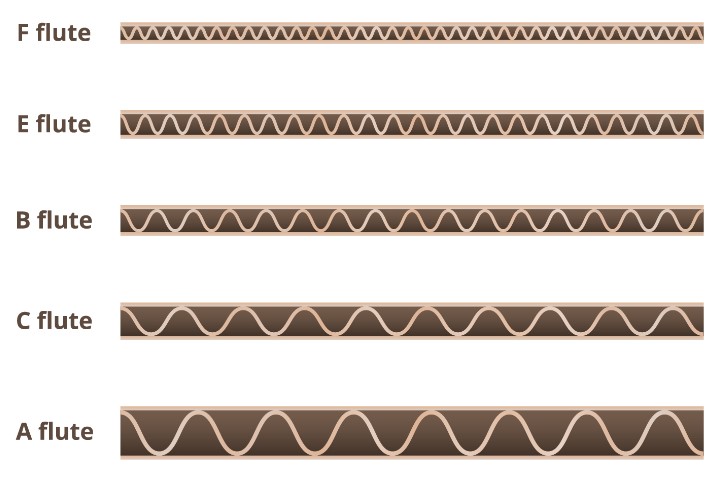Corrugated cardboard stands as a testament to innovation and durability, with a rich history spanning over two centuries. CrownPackages embarks on a journey to explore the origins and evolution of this remarkable packaging material, highlighting its enduring relevance in modern times.

The Anatomy of Corrugated Cardboard
At its core, corrugated cardboard features a distinctive composition characterized by a fluted layer securely bonded between two robust cardboard sheets. CrownPackages sheds light on the structural dynamics of corrugated cardboard, emphasizing its versatility in enhancing structural strength through varying fluted layer configurations. This fundamental arrangement serves as the cornerstone for corrugated cardboard sheets and the resulting packaging boxes.
A Paradigm Shift in Shipping
The inception of corrugated cardboard as a shipping solution traces back to the pioneering efforts of Malcolm McLean in 1871. CrownPackages delves into the groundbreaking idea conceived by McLean, which revolutionized global transportation processes by introducing corrugated cardboard boxes designed for efficient loading and unloading onto ships. This innovative concept not only expedited shipping operations but also set the stage for further advancements in packaging technology.
Propelling Corrugated Packaging Forward
Over the years, manufacturers have continued to refine corrugated cardboard production techniques, leveraging extensive research and customer feedback to enhance product performance. CrownPackages explores the evolution of proprietary lining and fluting, emphasizing the importance of internal innovation in ensuring the strength and durability required for securely packing and transporting valuable items.
Types of Corrugated Stock: Tailoring Solutions to Unique Needs
Corrugated stock encompasses a versatile array of materials tailored to meet diverse packaging requirements. CrownPackages offers insights into the various types of corrugated stock, ranging from Normal Slotted Glued Containers (RSC) to specialized configurations such as die-cut containers and multi-walled designs. Each type is carefully crafted to deliver optimal strength, durability, and protection for packaged goods.
Manufacturing Process of Corrugated Packaging
CrownPackages embarks on a journey to unravel the intricate process behind the creation of corrugated packaging, shedding light on its sustainable origins and remarkable recycling capabilities. By delving into the manufacturing process, we gain insights into the fundamental components that form the backbone of corrugated stock.
Sourcing and Recycling
Derived primarily from trees, corrugated packaging emerges as a sustainable solution, with a robust recycling infrastructure ensuring its continued eco-friendly footprint. CrownPackages emphasizes the industry’s commitment to sustainability, with a recovery rate reaching approximately 90% over the past eight years. Through meticulous collection, sorting, and compression, old corrugated containers (OCC) are transformed into compact bales, ready for the next phase of production.
Pulping and Formation
At the heart of the manufacturing process lies the pulping stage, where recycled corrugated material undergoes a transformative journey. CrownPackages illustrates the pulping process, likening it to a large blender, where fiber and water combine to form a slushy pulp. Through meticulous agitation and extraction of impurities, a continuous fiber mat is created, paving the way for the next stage of compression and moisture elimination.
Understanding Corrugated Flute Types
Corrugated packaging boasts a variety of flute types, each offering unique characteristics and applications. CrownPackages delves into the intricacies of A, B, and E flutes, shedding light on their respective strengths and suitability for different packaging needs.
A-Flute
A-flute, with its generous 5mm thickness, emerges as the optimal choice for items requiring superior cushioning and stacking robustness. CrownPackages highlights the exceptional cushioning properties of A-flute, making it ideal for safeguarding delicate products during transit.
E-Flute
E-flute distinguishes itself with its remarkably thin profile, measuring between 1mm to 1.5mm in thickness. CrownPackages emphasizes the outstanding strength of E-flute against squeezing and crushing, making it a preferred option for applications requiring both durability and space efficiency. Additionally, its smooth surface lends itself well to high-quality printing, enhancing brand visibility and aesthetics.
B-Flute
B-flute, with its thickness of around 3.2mm or ⅛ inch, strikes a balance between durability and space optimization. CrownPackages highlights the resilience of B-flute, capable of withstanding pressure without succumbing to crushing or puncturing. With approximately 49 waves per foot of packaging, B-flute proves invaluable for interior packaging where toughness is paramount.

Types of Corrugated Boards
The discussion extends to the various types of boards utilized in corrugated box construction, ranging from single-wall to triple-wall configurations. CrownPackages elucidates the distinct characteristics of each board type, from the versatile single-wall boards commonly found in shipping boxes to the sturdy triple-wall boards reserved for commercial components and produce bins. By aligning board selection with packaging needs, businesses can ensure optimal protection and transportation of their products.
Single-Wall Boards
Single-wall boards consist of one sheet of corrugated medium sandwiched between two sheets of liner. CrownPackages emphasizes the versatility of single-wall boards, noting their widespread use in shipping boxes and retail displays. Despite their simplicity, single-wall boards offer reliable protection and find utility across diverse applications, making them a staple in the packaging landscape.
Double-Wall Boards
Conversely, double-wall boards feature two sheets of corrugated medium nestled between three sheets of liner. CrownPackages underscores the structural integrity of double-wall boards, making them ideal for larger items or products requiring enhanced durability during transportation. With an additional layer of corrugated medium, double-wall boards provide superior strength and protection, ensuring the safe delivery of valuable goods.
Triple-Wall Boards
At the pinnacle of corrugated board design lies the triple-wall board, comprising three sheets of corrugated medium and four sheets of liner. CrownPackages highlights the exceptional robustness of triple-wall boards, which are commonly deployed for commercial components and the construction of produce bins. With multiple layers of corrugated medium and liner, triple-wall boards offer unmatched strength and durability, making them indispensable for heavy-duty packaging applications.

Conclusion
Corrugated cardboard’s impact on global transportation traces back to visionary innovators like Malcolm McLean, whose pioneering efforts revolutionized shipping operations with efficient loading and unloading processes. CrownPackages acknowledges the transformative power of corrugated cardboard in expediting shipping operations and fostering further advancements in packaging technology.
With a diverse array of corrugated stock types, CrownPackages offers tailored packaging solutions to meet unique requirements. From Normal Slotted Glued Containers (RSC) to specialized configurations like die-cut containers, each type is meticulously crafted to deliver optimal strength, durability, and protection for packaged goods.
Exploring flute types such as A, B, and E, CrownPackages highlights their unique characteristics and applications, offering insights into their cushioning properties and printing capabilities. Additionally, CrownPackages elucidates the distinct features of single-wall, double-wall, and triple-wall boards, aligning board selection with packaging needs to ensure optimal protection and transportation of products. CrownPackages continues to uphold the legacy of corrugated cardboard as a symbol of innovation, durability, and sustainability, offering bespoke packaging solutions tailored to the evolving needs of modern businesses.
